#Rivoli Theatre
Explore tagged Tumblr posts
Text
Vanished New York City Art Deco - The International Casino

View On WordPress
#Bond Clothes#Bond International Casino#Capitol Greyhound Bus Terminal#Capitol Theatre#Criterion Theatre#Donald Deskey#Gap#George Olsen and his Orchestra#Hammerstein&039;s Olympia#International Casino#Jardin de Paris#Loew&039;s New York#Manhattan#New York City#Night Clubs#Old Navy#Oscar Hammerstein I#Pennsylvania Greyhound Bus Terminal#Rialto Theatre#Rivoli Theatre#Roundabout Theatre Company#Strand Theatre#Streamline Moderne#Thomas Lamb#Times Square#Toys "R" Us#Wrigley&039;s#Wrigley&039;s Gum#Wrigley&039;s Spearmint Gum
0 notes
Text

PHILIP GLASS, Toronto 1989
I couldn't tell you why Philip Glass was giving a press conference in the backroom of the Rivoli on Queen West back in February of 1989, but he had a lot going on at the time and since memory fails me you'll just have to guess. Born in Baltimore in 1937, Glass is easily among the most famous composers alive today - a great accomplishment since his music, when it was first performed in the '60s, was considered hopelessly avant-garde. He accomplished this mostly by making himself ubiquitous - composing and performing his works everywhere he could, and taking on commissions like movie soundtracks to help make his distinctive version of minimalism less forbidding and more mainstream. I was part of that generation who came of age as Glass' music went from loft to music festival to opera house to movie theatre, so when I heard he was in town I tried to get a few minutes of his time for a portrait - and failed.



An invitation to a press conference with Philip Glass in the back of a club was my consolation prize when I couldn't arrange a portrait sitting. Normally I wouldn't have bothered, but I wanted to get some kind of portrait with Glass, and if an unposed, "undirected" portrait was all that was available, I'd take it. (I still debate whether this is a portrait at all, but a lot of people say it is, so I'll go with the crowd.) The late '80s were a crucial time for Glass: besides the soundtrack to Powaqqatsi (the sequel to Koyaanisqatsi, one of the great rep cinema stoner films of all time) he had provided one for Errol Morris' acclaimed documentary The Thin Blue Line, and he was working in more conventional classical idioms, like the string quartet and symphonic compositions. He could have been promoting any of these things when he sat down to talk to the press that morning in the Rivoli backroom.






When I pulled out my camera to photograph Philip Glass during a morning press conference in the back of a downtown club, the first thing I noticed was that there wasn't much in the way of light. I had come prepared, loading my Pentax Spotmatic with high speed Kodak film, but once I was able to judge that I had a decent exposure I was actually grateful. While I couldn't demand his attention like I could with a real portrait session, the single spotlight in that room with its black walls picked him out starkly; without any distractions in my composition, I was practically forced to take a minimalist portrait of a minimalist composer. In pursuit of this, I've pared down the pictures even more - taking out reflections and microphones, isolating Glass' face in each frame, tightening how the light hits his face with some digital assists. (I've even rendered one shot in colour, just to see what it would have looked like if I'd put colour film in my camera.) In the end I consider these more graphics than portraits, but they'll have to do until the (probably slim) chance I get to get Glass to sit down for a real portrait.

#portrait#portrait photography#photography#black and white#film photography#some old pictures i took#philip glass#composer#musician#pentax spotmatic#early work#undirected portrait#kodak tmax p3200
23 notes
·
View notes
Text

La Mode illustrée no. 46, 12 novembre 1865, Paris. Toilettes des Magasin du Louvre, 164 Rue de Rivoli. Ville de Paris / Bibliothèque Forney
Toilette de théâtre. Robe en poult-de-soie jaune d'or; le bas de la jupe est garni avec des entre-deux en dentelle noire composés de médaillons ovales, traversés perpendiculairement de distance en distance par des médaillions de même forme, mais plus grands, qui unissent les deux entre-deux et les dépassent; grand bournous (sp?) en dentelle noire. Chapeau composé de bandes de velours blanc, alternant avec des bouillonnés en crêpe rouge; brides rouges.
Theatre ensemble. Dress in golden yellow poult-de-silk; the bottom of the skirt is trimmed with black lace entre-deux composed of oval medallions, crossed perpendicularly at intervals by medallions of the same shape, but larger, which unite the two entre-deux and exceed them; large shawl in black lace. Hat composed of bands of white velvet, alternating with bouillonnés in red crepe; red straps.
—
Première robe en poult de soie blanc, bordée avec un étroit volant tuyauté, surmonté d'un dessin composé de trèfles exécutés en lacet d'or. Robe en velours bleu clair, bordée avec une frange de chenille bleue, mélangée de boules en or; cette robe est relevée devant et sur les côtés, et fixée sur la première robe par des cordelières bleues et or, formant un large trèfle terminé par des glands; corsage décolleté en poult de soie blanc, garni d'une broderie en tulle blanc; corselet en velours bleu, boutonné devant avec trois boutons d'or, encadré avec une corde bleue et or; manches courtes, bouillonnées en tulle. Coiffure antique avec diadème et bandelettes en or chaînette en or, retenant au cou une croix d'or. Gants blancs à quatre boutons (très-longs par conséquent).
First dress in white poult-de-soie, edged with a narrow piped flounce, topped with a design composed of trefoils executed in gold lace. Dress in light blue velvet, edged with a fringe of blue chenille, mixed with gold balls; this dress is raised in front and on the sides, and fixed on the first dress by blue and gold cords, forming a large clover finished with tassels; low-cut bodice in white poult-de-soie, trimmed with white tulle embroidery; blue velvet bodice, buttoned in front with three gold buttons, framed with a blue and gold cord; short sleeves, bubbled in tulle. Antique hairstyle with tiara and gold bands, gold chain, holding a gold cross at the neck. White gloves with four buttons (very long consequently).
—
Dernière remarque. La robe de velours forme une longue queue par derrière.
Last remark. The velvet dress forms a long tail at the back.
#La Mode illustrée#19th century#1860s#1865#on this day#November 12#periodical#fashion#fashion plate#color#description#Forney#dress#shawl#gown#evening#theatre#Modèles de chez#Magasin du Louvre
15 notes
·
View notes
Text
Today you're getting trivia dump on the musical The Drowsy Chaperone because I saw it last night and it's immediately become one of my dream shows (with the dream role of Man in Chair of course- look as a theatre kid who can't sing of course I'm going to latch onto a monologue-heavy character).
Let's begin!
The musical originated as an entertainment piece for the bachelor party of real life couple Bob (Robert) Martin (Canadian writer and actor) and Janet van de Graaf (Canadian improv and television artist). It was performed at the Rivoli Night Club and the admission costs were used to help fund their wedding
The original show did not have the role of the Man in Chair!
Despite having less than stellar reviews (notably being called a "sleeper" and having "forgettable" songs by critic Ben Brantly), TDC recieved thirteen Tony nominations and won five (Book, Original Score, Featured Actress, Scenic Design, and Costume Design)
The first translated version of the show opened in Japan (January 5th, 2009)
In the original Broadway production, during the Man in Chair's "intermission monologue", there's an added line about the Morosco theatre being torn down and a hotel being put in it's place. This line is a reference to the Marquis Theater (where the run took place) being part of the Marriott Marquis complex which was built where the Morosco Theater once stood.
The use of a deus ex machina in the form of Trix's plane at the end of the second act is one of the most literal version of the trope. The history of the term comes from ancient Greek performances, where, in resolution to conflicts, the Greek gods would appear in the show, often being delivered to the stage via a crane. So, the appearance of a character who can resolve the unsettled issue via a device from the sky is a fitting homage to the trope.
The Drowsy Chaperone is qualified as both a parody and a pastiche. If you didn't know what a pastiche means (aka me about five minutes ago), a parody mocks aspects while a pastiche celebrates aspects. Some examples of other pastiches are Rosencrantz and Gildenstern are Dead (for Hamlet) and The Second Mrs Darcy (Pride and Prejudice).
The song Love is Always Lovely in the End replaced a song in the original production titled I Remember Love
In many productions, the animal Robert is compared to in Bride's Lament is changed from a monkey to a bunny to avoid racist undertones.
Aldopho says his name 15 times in the song I am Aldopho (the chaperone says it four times)
Whilst on Broadway, TDC had 32 previews and 674 performances before it closed in 2007.
Robert and George's tap dance before Underling's entrance in Cold Feet is approximately 1 minutes and 32 seconds long.
The longest song on the cast recording is Bride's Lament at 5:13, whilst the shortest (excluding Man in Chair's actor backgrounds) is the Act 1 Finale with 47 seconds.
#the drowsy chaperone#musical theatre#trivia#sutton foster#broadway#theatre#theater#theatre kid#tdc#robert martin#janet van de graaff
15 notes
·
View notes
Text

Everyday Poetry - "I believe that in a great city, or even in a small city or a village, a great theatre is the outward and visible sign of an inward and probable culture." Laurence Olivier
[Teatro Rivoli - Porto - Portugal - 13.07.2024]
18 notes
·
View notes
Text
I've rewatched all of Ted Lasso in the last few days. Here are some random Series 1 rewatch thoughts that no-one asked for.
I got a bit distracted towards the end and I didn't even bother to split it by episode, but I doubt anyone is going to read this anyway!
Ted and Beard are flying on DubaiAir, the sponsor of Richmond. Why aren't they in first/business class?
Ted looks so fucking cute and soft when he gets off the plane. I think this is probably where I fell in love with him.
It is hilarious that they go all the way to Tower Bridge from Heathrow when they would have to drive past Richmond (also why is Ollie still holding the sign with Ted's name on when they get there?!)
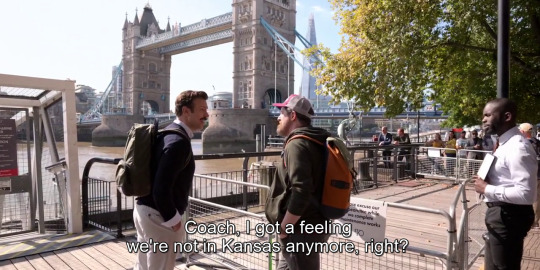
He likes my glasses? I guess I'll have to marry him one day...
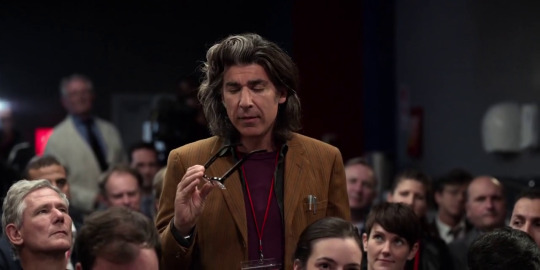
I miss Colin's longer hair.
How adorable is Series 1 Bumbercatch? Little did I know back then that he'd become a favourite.

Trent is already smitten. Jeez Louise.
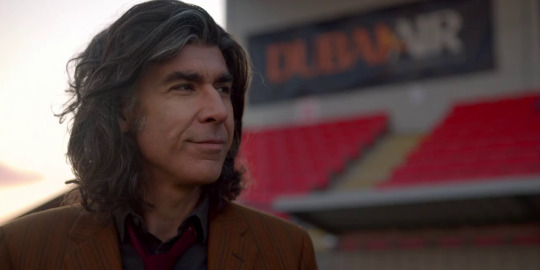
Isaac looks so good in glasses.
Sam thanking the photographers for taking his picture at the gala is beyond adorable.
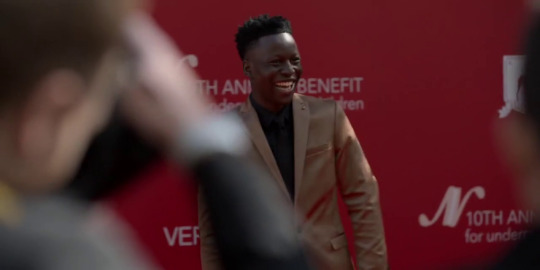
Isaac and Colin and Richard all look so good in their suits.


I can't believe they filmed at the Rivoli Ballroom as the interior of Richmond Theatre. It is so close to where I live. They were right there and I didn't know. 😩
Knowing what we know about Jamie now, the player auction is PAINFUL. I feel so protective over Jamie now, but at the time I severely disliked him.
Roy correctly uses the term prima donna. Twice. But he says pre-Madonna in series 3.
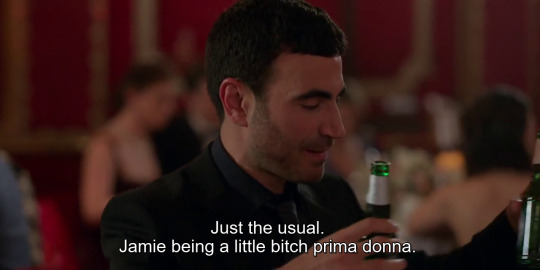
Why is this hug so funny to me?
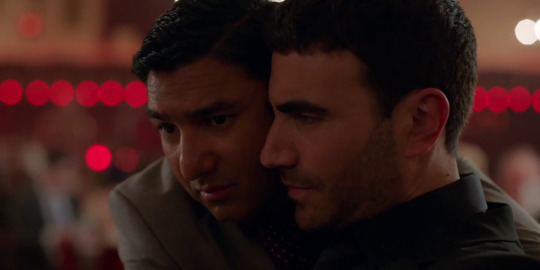
I didn't remember Ted saying 'plan' in an English accent copying Rebecca when he has semantic satiation. It is brilliant. As is his reaction to flan.
Interesting use of a Dutch angle when Ted is laying into Jamie. I don't think we see that used at any other point in the show.
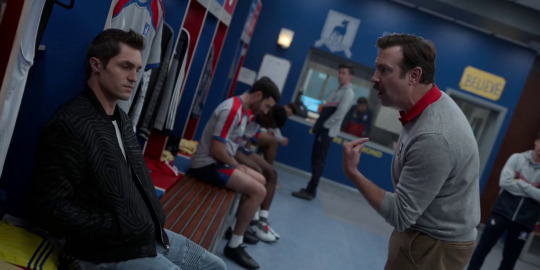
No seriously. Why is Isaac not in glasses all the time?? Look at him.
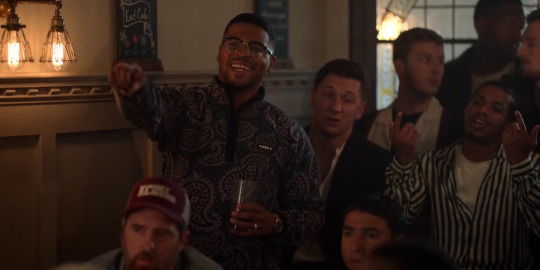
I will never be over them setting something on fire on a Premier League pitch, dear god. 😩
Ted correctly names Sex and the City which he failed to do in series 3.
Earlier this week I wondered if Colin's nan would speak to him again if he got to play for Wales in the upcoming International Break episode. I didn't remember that she died. Sorry, Colin.
Colin's set piece suggestion is called Beckham's Todger. 🤦🏼♀️
Interesting that Nate uses a video of Jamie being a prick about Richmond to motivate the team like Roy and Beard using one of Nate in series 3. Both end in violence and Richmond losing.
#and those are my thoughts#that noone asked for#ted lasso#ted lasso rewatch#i'll go add some pictures to my series 2 one now#which also noone asked for but whatevs
28 notes
·
View notes
Text

In this cut scene (what would have been one of the film's lighter moments), Cleopatra, Antony, and Caesarion horseplay following a mock battle between Cleopatra's lover and son.
* * * *
#Cleopatra60: Director Joseph L. Mankiewicz envisioned "Cleopatra" as two films: "Caesar and Cleopatra" and "Antony and Cleopatra," in the grand tradition of Shaw and Shakespeare. Fox refused, reasoning that two separate films would be a logistical nightmare and audiences were most interested in seeing Elizabeth and Richard share the screen (Antony only briefly appears in the first half).
The initial rough cut of the film ran five hours and twenty minutes. With Fox president Darryl F. Zanuck breathing down his neck, Mankiewicz cut an additional 77 minutes—and much of the film's characterization—which would be its length when it finally premiered at New York's Rivoli Theatre on June 12, 1963.
In the mid-1990s, a world-wide search was carried out in hopes of restoring the film to a six-hour director's cut length. While a few scraps have turned up—including the Egyptian queen in exile at her seaside camp, which would have been our first glimpse of Elizabeth in the film if Mankiewicz had had his way, as well as B-roll footage—the search was futile.
"As a cost-cutting measure, the studio decided in the late 1970s to get rid of all of its trims and outs from its older pictures," explained Schawn Belston, then Senior Vice President, Library & Technical Services at 20th Century Fox. "All the trims and outs from 1978 back were destroyed. There wasn't yet the idea of alternate versions for DVD or Blu-ray. There was no market value for this material and there wasn't any vision for there ever to be any."
"I think it speaks to the reputation of the movie that people want more of it."
In this cut scene (what would have been one of the film's lighter moments), Cleopatra, Antony, and Caesarion horseplay following a mock battle between Cleopatra's lover and son.
[Elizabeth Taylor Archives]
13 notes
·
View notes
Text
Lost, but Not Forgotten: Racing Hearts (1923)









[alternate title: Have a Heart]
Direction: Paul Powell
Scenario: Will M. Ritchey
Story: Byron Morgan
Camera: Bert Baldridge
Studio: Paramount & Famous-Players Lasky
Performers: Agnes Ayres, Richard Dix, Theodore Roberts, Robert Cain, J. Farrel McDonald, Warren Rogers, Robert Brower, James A. Murphy
Racing Stunts: James A. Murphy, Jerry Wonderlich (or Wunderlich), & Agnes Ayres
Premiere: Opening week: 18 February 1923, Rivoli Theatre, New York, NY
Status: presumed entirely lost
Length: 5,691ft or roughly 60 minutes
Synopsis (synthesized from magazine summaries of the plot):
Does advertising work? Virginia “Ginger” Kent (Ayres) thinks it’s just the ticket to save her family’s failing automobile company. Unfortunately, her cigar-champing father, John Kent (Roberts) abhors advertising.
Ginger takes matters into her own hands and speeds her way through a town where she knows the judge really throws the book at speeding motorists. Her hope is that getting her name and the name of her father’s car, “Granada,” in the papers will drum up interest. However, on that very day, Roddy Smith (Dix) is temporarily filling in for the local traffic cop. Roddy happens to be the son of the manufacturer of a rival car called the “Mono.” Roddy instantly falls in love with Ginger and convinces the judge to let her walk—inadvertently foiling her plan to get the Granada in print.
Later, Ginger’s father takes a business trip to London, leaving Ginger with instructions to fulfill in his absence. Ginger sees an opening and forges instructions for the factory’s foreman to build a racing car according to her specifications.
Meanwhile, an employee of the Kent’s is secretly talking to Smith, Sr. about the Kent’s financial troubles and trying to finagle a buy out. Smith, Sr. directs his son to go undercover and scope out the Granada operations. Roddy ends up hired to work on the racing car.
Ginger plans on entering the car in The Vanderbilt Cup, taking place in Santa Monica. Everything is going smoothly, until just before the race. The factory superintendent (Cain) that Ginger chose to race the car is a turncoat and has taken money from Smith, Sr. to throw the race. Roddy is also revealed to be a Smith in disguise and his father forces him to drive one of his own company’s cars in the race. So, in a momentous turn of events, Ginger has to race the car herself.
In the final stretch of the race, Ginger is in the lead—until she runs out of gas! Roddy sacrifices his chance at winning and uses his car to push Ginger across the finish line, which results in him crashing out. It’s all worth it though, as the Kent company is saved and Roddy and Ginger couple up.
Additional points of interest: In the opening sequence of the film, to illustrate stunt advertising, a car is seen floating above a city attached to a balloon. I couldn’t quite sort how/where this would fit into the plot synopsis, so I stuck it here!
Real-life racer Jimmy Murphy not only does stunt driving for the film, but also has a cameo as an out-of-work racecar driver.
Ayres reportedly did some of her own driving on the racetrack, exceeding 100mph!
Buy me a ☕
Transcribed sources & annotations below:

Paramount Pep, 30 October 1922
Agnes Ayres a Speed Demon
“Racing Hearts” has been chosen as the title of the new Agnes Ayres picture which has just gone into production under the direction of Paul Powell. This story is an original by Byron Morgan, who is well known for his unusual success as a writer of fiction which has automobile racing as a background. Miss Ayres is seen in the production at the wheel driving a racing car at a rate of one hundred miles an hour. She has been practicing for this production on the Los Angeles Speedway during the past two weeks, using a genuine racing car which has been a victor in several big contests. When the big racing scenes of the production are staged Miss Ayres will be supported by a half dozen of the greatest automobile drivers in America, men who have won fame at races at Indianapolis and other speedways throughout the country. The scenario is by Will M. Ritchey. The cast of this picture includes Richard Dix in the male lead, Theodore Roberts, Robert Cain, J. Farrel McDonald and Warren Rogers.
NOTE: One of many mentions of Ayres doing her own driving, and at 100 mph! With a 1922/3 car!
---
Paramount Pep, 6 November 1922
In and Around Paramountown
The famous Jerry Wonderlich, victor of many a racing duel, is heading the group of automobile racers appearing in “Racing Hearts,” the latest Agnes Ayres production. Miss Ayres herself drives in race scenes of this picture at a rate in excess of 100 miles an hour. Richard Dix, her leading man, is called upon to meet this speed in another motor car, and likewise to travel at over 60 miles an hour upon a motorcycle.
It is said that the production is entirely different from the usual run of Agnes Ayres’ pictures, and presents her in a virile, out-door type of rôle. “Racing Hearts” was written for Miss Ayres by Byron Morgan, perhaps America’s greatest writer of automobile racing fiction. The story was adapted for the screen by Will M. Ritchey and is being directed by Paul Powell.
NOTE: Jerry Wunderlich/Wonderlich filmed this movie in between his two Indy 500 appearances. Unfortunately, like James Murphy, Racing Hearts appears to be his only feature film work!
---
Moving Picture World, 11 November 1922
News from the Producers
Conducted by T.S. da Ponte
Changes Titles of Two
Three new titles have been chosen for as many forthcoming Paramount pictures.
William de Mille’s recently completed production from an original story by Clara Beranger, in which Bebe Daniels, Lewis Stone, Kathlyn Williams and Harrison Ford have the important roles, has been permanently titled, “The World’s Applause.” “Notoriety” was the title originally chosen, but when it was found that another company had a prior claim, it was changed temporarily to “Paths of Glory,” which in turn has now given way to “The World’s Applause.”
Mary Miles Minter’s latest picture, just completed under the direction of Charles Maigne and adapted from Stephen French Whitman’s novel, “Sacrifice,” is to be called “Drums of Destiny.”
“Racing Hearts” is the title chosen for the new picture Agnes Ayres is just starting under the direction of Paul Powell. This is a story by Byron Morgan, author of the Wallace Reid automobile racing pictures, and Miss Ayres has the role of a race driver who goes in and wins a thrilling speed contest when the regular driver fails to show up.
NOTE: Both “Drums of Destiny” (titled “Drums of Fate” on release in 1923) and “The World’s Applause” are also lost films. I covered “The World’s Applause” first in this series.
---
Paramount Pep, 13 November 1922
Racing Scenes
Outdoor racing scenes have been completed for “Racing Hearts,” the new Agnes Ayres picture. Paul Powell is now working indoors at a set representing the interior of a racing garage on the eve of a big speed battle in which Miss Ayres drives a car at over 100 miles an hour. The famous Jerry Wonderluch and other nationally known racing drivers take part in this sequence.
---

Paramount Pep, 27 November 1922
The Nono Doll
Although Paris started the fad of the Nono dolls as mascot, Agnes Ayres soon acquired one as a regular part of fashion.
We understand Miss Ayres will display her little pet in her latest picture, “Racing Hearts.”
NOTE: I have not been able to find anything about Nono Dolls as they relate to Paris in the 1920s, but I’m assuming that they are a brand of boudoir doll, which were popular with flappers at the time.
---

Motion Picture News, December 1922
Agnes Ayres Picture Has Thrills Aplenty:
REMEMBER those wonderful automobile pictures—”Too Much Speed,” “The Roaring Road,” “Excuse My Dust,’ “What’s Your Hurry?” Across the Continent,” etc.—that Wally Reid made from the stories of Byron Morgan? Will you ever forget them? Well, in “Racing Hearts” you have Agnes Ayres risking her precious life in just that kind of a picture by the same author. Like the others, it’s a comedy-drama with thrill following thrill upon the automobile racetrack and boulevard. Some famous drivers take part in the race which Agnes wins in a most sensational finish. Yes, Theodore Roberts, with his familiar cigar, is here again as the father, with Richard Dix playing the leading man’s part and Robert Cain doing a lot of dirty work. Paul Powell directed this one—one of those triple-guaranteed speed pictures that can’t go wrong.
There is no present-day fiction writer who possesses more of the human touch than Clarence Budington Kelland, whose stories appear in Red Book. “Contraband,” another production in which Miss Ayres appears for Paramount was published serially, starting in the issue of May, 1922, and is the story of a young girl, charming, attractive, but poor, who suddenly finds herself, through the death of an uncle, owner of a small-town newspaper. She moves in and runs it, and runs it right, without fear or favor, thereby provoking the anger of a wealthy old rascal who holds a mortgage on the paper and is determined by hook or crook to own and control it.
How Miss Ayres, as Carmel Lee, confounds him and sets him where he belongs, makes great screen entertainment. The scenario is by Beulah Marie Dix and Paul Powell is the director.
NOTE: I looked up the other film mentioned here, “Contraband,” but it looks like it wasn’t completed or released. Apparently they began production on it in late January 1923, with Wesley Ruggles in the director’s chair and may have shot for a handful of weeks, but I wasn’t able to find reference to it beyond it being “in production.”
---
Paramount Pep, 13 December 1922
Around Paramountown
(Continued from page 12)
Agnes Ayres’ picture, “Racing Hearts,” will progress rapidly to its conclusion. It was necessary that Paul Powell, the director, have a number of racing cars for use in the big race scene of the picture and these were not available until after the annual event. This is a Byron Morgan automobile story adapted by Will M. Ritchey, and Richard Dix plays the male lead with Theodore Roberts, Robert Cain and others in the cast.
---
Camera, 16 December 1922
Complete
“Long Skirts,” starring Fatty Karr, directed by Bruce Mitchell for East Coast Productions. Federal.
“The White Flower” starring Betty Compson: written and directed by Julia Crawford Ivers; Paramount.
“Racing Hearts,” starring Agnes Ayres; directed by Paul Powell; Paramount.
NOTE: Couldn’t find much information at all about “Long Skirts” other than its production and completion, but if it was released it was likely in 1923. It’s a two-reeler also starring Joe Murphy, Lilymae Lyle (or Lilymae Wilkinson), Geary O’Dell (or Garry O’Dell), Phillip Dunham. It was written by Ward Hayes and shot by Vernon Walker.
“The White Flower” (premiered March 4, 1923, considered lost)
---

Exhibitor’s Herald, 23 December 1922
Baron deForrest on a recent visit to Paramount studios on Coast stated that London had turned down all censorship and blue laws. Cheer-o for London. In the picture are the baron, his son and Theodore Roberts, playing in “Racing Hearts.” Note the manner in which Los Angeles press played up Paramount convention held there.
---
Motion Picture News, 27 January 1923
Racing Hearts” Completed by Powell
Paul Powell has completed his Paramount production of ” Racing Hearts,” starring Agnes Ayres, and the film is now in the cutting room at the Lasky studio. Heavy rains delayed the production of this automobile story by Byron Morgan, making it too dangerous to undertake the big road racing scenes.
---
Moving Picture World, 27 January 1923
Five New Paramounts Finished on Coast
A perfect picture of industry last week, the Paramount West Coast studio has been comparatively quiet for several days. For the first time in many months, only four companies are at work, where nine units were busy for many weeks before.
The five companies that completed production almost to a day were Joseph Henaberry’s unit producing “The Tiger’s Claw,” starring Jack Holt, with Eva Novak and Eileen Pringle in the leading feminine roles; “Bella Donna,” George Fitzmaurice’s production, which is Pola Negri’s first American starring vehicle; Walter Hiers’ first starring picture for Paramount; “Mr. Billings Spends His Dime,” while the cutting and assembling was completed on “The White Flower,” starring Betty Compson, and “Racing Hearts,” in which Agnes Ayres starred.
The four companies now on production at the studio are the William de Mille unit, producing “Grumpy,” with Theodore Roberts, May McAvoy and Conrad Nagel featured; “The Trail of the Lonesome Pine” unit, in which Mary Miles Minter stars and Antonio Moreno is featured in support; “Prodigal Daughters,” Sam Wood’s production starring Gloria Swanson, and “The Law of the Lawless,” starring Dorothy Dalton, with Theodore Kosloff and Charles de Roche featured in support.
That the studio will soon be once more a hive of industry is indicated by the fact that production will begin within the next few days on “The Rustle of Silk,” starring Betty Compson; “Contraband,” starring Agnes Ayres; “The Cheat,” starring Pola Negri and other pictures.
NOTE: “The Tiger’s Claw” (premiered 18 March 1923, presumed lost),
“Bella Donna” (premiered 1 April 1923, reported to be extant at Gosfilmofond Archive, but not accessible via home video or online. It’s listed in their online catalog but without details about the holding.),
“Mr. Billings Spends His Dime” (premiered 19 March 1923, presumed lost),
“The White Flower” (premiered March 4, 1923, presumed lost)
“Grumpy” (premiered 11 March 1923, reported to be extant at Gosfilmofond Archive, but not accessible via home video or online. It’s listed in their online catalog [under “БРЮЗГА“] but without details about the holding.),
“The Trail of the Lonesome Pine” (premiered 15 March 1923, presumed lost),
“Prodigal Daughters” (premiered 15 April 1923, presumed lost),
“The Law of the Lawless” (premiered 22 July 1923, presumed lost),
“The Rustle of Silk” (premiered 13 May 1923, presumed lost),
“Contraband” seems to have never been completed or released, as described in a note above.
“The Cheat” (premiered 27 August 1923, presumed lost)
Welllll, that’s a depressing list.
---

Paramount Pep, 21 February 1923
Our New Leading Man
One of the latest to sign up as a leading man is Richard Dix, shown here in the Mono-flyer that he drove in the big race playing opposite Agnes Ayres in “Racing Hearts.”
As stated in a previous issue of PEP, Mr. Dix has signed a contract for five years.
Congratulations and a hearty welcome to our big family.
---
Camera, 24 February 1923
THE SILENT TREND
Frankly, it has been difficult for the average picture-goer to understand why Agnes Ayres is a star! And, it must be confessed that she has disappointed in several of her screen characterizations. But, she seems to have found her plane to some extent in “Racing Hearts,” her latest picture for Paramount. In this photodrama of geared-up action, she does the best work of her career—not truly stellar performing of artistic finesse, but satisfactory interpreting of a role for which she is suited. Here is an automobile story quite unusual in that it has provided opportunity for just about the most exciting auto races ever filmed. During some of the more exciting race moments, it is impossible to restrain yourself from getting up on your feet and letting out an obstreperous whoop. Near the finish there is a mishap in the form of a “spill” and this all but makes one swoon. To attain such heights of arousing excitement is an achievement for which Paul Powell deserves credit. One of the unusually interesting features of “Racing Hearts” is, Jimmy Murphy, the real thing in the automobile-racing world, who appears briefly in the role of a driver out of a job. Richard Dix is in the cast contributing those ingratiating qualities of his, and Theodore Roberts is also among them in his usual flawless acting form.
NOTE: A recurring comment about this film is that Agnes Ayres found her footing as a star in this film, even though she had been in prominent roles for years by this point. (I’m assuming here that this was a commonly held opinion—though we can’t really know since so many of her films are lost.) Prior to this film Byron Morgan had provided stories for a handful of racing vehicles (pun intended) for Wallace Reid, one of which featured Ayres as the romantic interest: “Too Much Speed” (1921, presumed lost). It’s kind of sweet that taking the same type of story but remixing it so Ayres would be both the lead and the racer fit her so well.
---

Exhibitor’s Herald, 24 February 1923
REVIEWS
AGNES AYRES IN
RACING HEARTS
(PARAMOUNT)
Here’s a capital automobile story, chock full of action and one of the best staged and most exciting automobile races ever screened. It fairly raises you out of your seat. Many opportunities for exploitation in this one. Directed by Paul Powell. Seven reels.
We feel sure you’ll like this latest Paramount picture, which is all about a pretty girl, a good looking hero, a stubborn father and rival automobile manufacturers. Agnes Ayres does some of the best work of her entire career. And you’ll like Richard Dix, a natural and thorough actor, with a winning smile and a wonderful personality. Add to this Theodore Roberts, with a pocketful of cigars, stubborn owner of a manufacturing plant; Robert Cain, as Claxton, in his employ, and tricky; Warren Rogers, as Jimmy Britt and J. Farrell MacDonald, as Silas Martin, a banker. A flash is given also of Jimmy Murphy, who poses briefly as a driver of high-speed cars, out of a job.
The story is quite ordinary, based on the old, old theme of rivalry between two automobile families, and yet by careful handling and an especially well handled automobile race, is made to live and become acutely interesting, as well as very human and real.
There is a “spill” near the finish of the race that’s a real thriller and the blase film fan that doesn’t get a “kick” out of that race is dead from the neck up.
The story runs thus: Virginia Kent. known as “Ginger,” Kent forges a letter of instructions to the foreman of her father’s plant, which permits her to hire outside help and build a racing machine, while her father is in Europe on a business trip. Roddy Smith, son of a rival manufacturer, is hired as an expert mechanic by Virginia. The machine is finished and he has tentatively agreed to drive it in the Vanderbilt race, when his father exposes him to Virginia. She hires an unscrupulous superintendent in the factory to drive the car, but he plans to lose the race, and thus ruin her father. At the last moment he is exposed. and Virginia drives the car. On the home stretch of the last lap of the race her gas gives out, and Kent who is driving his father’s car, pushes her over the tape, but wrecks his own car. Of course the romance started in the factory is continued and it all ends happily.
---
Moving Picture World, 24 February 1923
“Racing Hearts”
Agnes Ayres Makes Good in Her Dramatic Picture for Paramount.
Reviewed by Joseph Ester
Speed fans will get their fill when they see “Racing Hearts,” Agnes Ayres’ latest Paramount production. Automobiles play a big part throughout the film and the stunt of sending a motor car aloft as ballast for a balloon right at the beginning to attract attention of people of the city marks it as a novel picture.
Plenty of action is the big theme and there is always something doing when Agnes Ayres as Ginger, the daughter of John Kent, automobile manufacturer, capably played by Theodore Roberts, is on the scene. ‘Racing Hearts” serves to bring out Miss Ayres in a new characterization, and Richard Dix as Roddy Smith has to step some to keep up with her, but makes the grade and helps to turn out an interesting picture.
The big race scene when Miss Ayres takes the seat of the driver who turns yellow at the last minute and refuses to drive and the smashup of Roddy Smith to allow her to win the race are realistic and keep the audience interested to the end of the film. There are flashes of real comedy in this picture that help to relieve the excitement of the racing sets, and, under the direction of Paul Powell, the picture is handled in a capable manner.
Any person with red blood in their veins will like ‘Racing Hearts,” and you can use plenty of publicity in playing up this picture, as it is worth it.
Cast
Virginia Kent…Agnes Ayres
John Kent…Theodore Roberts
Roddy Smith..Richard Dix
Fred Claxton…Robert Cain
Jimmy Britt…Warren Rogers
Silas Martin…J Farrell MacDonald
Based upon story by Byron Morgan.
Scenario by Will M. Ritchey.
Photography by Bert Baldridge.
Direction Paul Powell.
Length, 5,600 feet.
Story
Virginia Kent, speeding in her father’s car, is arrested by Roddy Smith, not a real cop but substituting on that particular day. Mr. Kent’s motor car business Is in bad shape and his manager tries to get Roddy’s father, a competitor, to buy up the Kent business. Affairs lead to a race in which Virginia begs Roddy to drive her father’s car, but, as he is pledged to drive his own father’s, she is forced to enter the race herself. She wins and Roddy wins her.
---
The Film Daily, 25 February 1923
Pleasing Romance And Good Auto Race Chief Points of Appeal
Agnes Ayres in
“RACING HEARTS”
Paramount
DIRECTOR…Paul Powell
AUTHOR…Byron Morgan
SCENARIO…Will M. Ritchey
CAMERAMAN…Bert Baldridge
AS A WHOLE…Slight but agreeable feature that contains fair excitement in racing sequence
STORY…Satisfying romance with rather familiar situations although they are nicely handled
DIRECTION…All right ; racing sequence effectively done and furnishes some thrills.
PHOTOGRAPHY…First rate
LIGHTINGS…Good
STAR…Pleasing and usually convincing
SUPPORT…Very good ; Richard Dix, good lead and Theodore Roberts splendid, as usual
EXTERIORS…Appropriate
INTERIORS…Not many
DETAIL…Ample
CHARACTER OF STORY…Daughter of automobile manufacturer, in latter’s absence, has racer built that wins and makes the car famous
LENGTH OF PRODUCTION…5,691 feet
Agnes Ayres has a story somewhat different from her recent vehicles in Byron Morgan’s “Racing Hearts,” an automobile story that furnishes a satisfying entertainment, of rather light weight but containing sufficient good incident, pleasing romantic situations and a cast that gets it over. The theme doesn’t vary greatly from some of those that served Wallace Reid so capably in several of his pictures that proved thoroughly popular, so “Racing Hearts,” will undoubtedly be well received by a majority.
Richard Dix, who is rapidly coming to the fore as a leading man, plays the role that Reid did so well—the good looking young racer who mixes love with his favorite sport. Dix handles the role very well and, while he isn’t quite as convincingly romantic as Wallie, he will please them and he makes a satisfying opposite for the star. Agnes Ayres makes the most of the role of the automobile manufacturer’s daughter who hits upon a scheme to make her father’s product sell by stunt advertising, an idea abhored by the old gentleman—Theodore Roberts contributing the humorous touches as the contrary parent.
In spite of the very slight material at hand, Director Paul Powell has succeeded very well in maintaining an even interest throughout and where it was necessary to do some padding, he has done so without lessening the speed. Toward the end he supplies some first rate thrills in the racing sequence and the cameraman is also to be credited with good work in shooting these scenes.
Of course there is never any doubt as to what the outcome will be but this won’t spoil the picture for those who like stories of a highly romantic flavoring such as this. There is a wicked villain who plots with the owner of one of the competing cars to prevent the other winning but it is all very mild plotting and never threatens to cause any serious damage to the love affair of the daughter and son, respectively, of the contesting owners. The only standard make of car that gets any prominence in the film is the Durant, the others are all made up names.
Story : Virginia Kent’s father refuses to go in for “stunt” advertising so his make of automobile, the Granada, is not nearly as popular as that of his enemy, the Mono, made by Smith whose son, Roddy, is in love with Virginia. How Virginia, in her father’s absence, has a racer built and entered in the road race, and drives it to victory herself when she learns the driver has been bought by Smith, is coupled with the reunion of Virginia and Roddy who drove his father’s car off the track to allow Virginia to win.
Star’s Admirers Will Like It And Racing Sequence Will Interest
Box Office Analysis for the Exhibitor
Admirers of automobile racing stories will be well pleased with this latest Agnes Ayres picture, “Racing Hearts,” and there are enough good talking points in it for you to get them interested without a great deal of trouble. A trailer of the racing sequence will make them want to come back to see the entire picture, especially if you show a shot of the final spill.
The star’s admirers will like her work in this and you can promise them a story a little different from those she has had recently. Talk about the good supporting cast using the names of Richard Dix, Theodore Roberts. Stunt advertising and exploitation will also do very well to arouse their curiosity.
---
Educational Screen, March 1923
THE THEATRICAL FIELD
RACING HEARTS (Paramount)
This is one of Byron Morgan’s stories the “roaring road,” the sort of thing that Wallace Reid used to romp through so debonairly. Theodore Roberts is familiar as the fierce, cigar-chewing old manufacturer of automobiles, l who doesn’t believe it pays to advertise. Agnes Ayres plays his headstrong daughter who takes advantage of his absence to have a racing car built in the hope of winning the Vanderbilt cup, and recouping the fortunes of the factory. Richard Dix is pleasant as the rival manufacturer’s son who loses the race and wins the girl. The famous racing driver, “Jimmy” Murphy is played by a modest and camera-shy young man by the name of James A. Murphy, greatly to the delight of race enthusiasts who recognize him. Some very good race scenes, including one or two narrow escapes and one honest-to-goodness spill, furnish the excitement. (Community.)
NOTE: Tragically, Jimmy Murphy died in a race in September of 1924. While there is some extant footage of him racing, Racing Hearts is his only known feature film appearance!
---

Screen Opinions, 1 March 1923
“RACING HEARTS”—Class A
(Adapted from story of same name)
Story:—Daughter Overrules Father’s Aversion to Advertising; Wins Road Race
VALUE
Photography—Very good—Bert Baldridge.
TYPE OF PICTURE—Sporting—Fascinating.
Moral Standard—Average.
Story—Very good—Comedy-drama—Family.
Star—Very good—Agnes Ayres.
Author—Very good—Byron Morgan.
Direction—Very good—-Paul Powell.
Adaptation—Very good—Will M. Ritchey.
Technique—Good.
Spiritual Influence—Neutral.
Producer—Paramount
CAST
Virginia Kent…Agnes Ayres
Roddy Smith…Richard Dix
John Kent…Theodore Roberts
Fred Claxton…Robert Cain
Jimmy Britt…Warren Rogers
Silas Martin…J. Farrell MacDonald
March 1 to 15, 1923.
Footage—5,000 ft.
Distributor—Famous Players
Our Opinion
MORAL O’THE PLAY—It Pays to Advertise.
Spirited Comedy-Drama Presents Agnes Ayres in Peppy Role
“Racing Hearts” brings memories of that splendid series of automobile stories in which Wallace Reid appeared not so very long ago. And the fact that Theodore Roberts is cast as before in the role of an automobile manufacturer and father to an irrepressible young person serves to intensify the impression that the late actor should have his place in the cast. However, Agnes Ayres gives such a spirited performance, looking as pert and winsome as any flapper, that we are amply satisfied, and Richard Dix, as the regretful son of the opposing party, who has fallen before the smiles of the fascinating Virginia Kent, is quite as we would picture the romantic son of a sport king. Theodore Roberts is as always master of the situation, and Robert Cain is excellent as the heavy. The cast is good throughout, with Robert Brower, Warren Rogers and J. Farrell MacDonald getting in fine work. The racing scenes are well photographed, and one or two real thrills are staged in which accidents which seem to be very real occur. You can bank on this picture. Book it on the reputation of former auto racing pictures.
STORY OF THE PLAY
Virginia Kent, daughter of John Kent, manufacturer of the Grenada automobile; is so impressed with the idea that her father is losing. out to his chief competitor, Smith, of the Mono machine, that she decides to try a little advertising of her own. Her first venture is in speeding at sixty miles an hour, which, however, fails to get her into jail, and thereby into the newspapers, because Roddy Smith, who is substituting for the cop, falls in love with her at first sight. Later, when Dad is over in London, she has a racing car built for Granada, and because the driver is being bribed by Smith, Sr., she drives it to victory herself. The story ends with Dad’s fortunes taking a turn for the better, and Virginia and the son of the enemy betrothed.
PROGRAM COPY—”Racing Hearts”—Featuring Agnes Ayres
If you are longing to see another of those peppy Paramount automobile pictures with hairbreadth escapes on a dusty track, don’t miss “Racing Hearts,” with Agnes Ayres, Theodore Roberts and Richard Dix. It’s a pippin’!
---
Exhibitor’s Trade Review, 3 March 1923
RIVOLI
1. Overture—Rienzi (Richard Wagner)
2. Risenfeld’s Classical Jazz
3. Rivoli Pictorial
4. Message of Emile Coue
5. Gavotte Louis XIII
a) Miriam Lax, Soprano
b) Inga Wank, mezzo soprano
c) Jean Booth, contralto
d) The Serova Dancers
6. Feature—Agnes Ayres in Racing Hearts
7. Mighty Lak’ a Rose Marcel Atwell, soprano (Ethelbert Nevin)
8. Casey Jones, Jr.
Press Comments
World—Is quite a snappy little film comedy. Tribune—The story is simple, but amusing. A picture called “The Message of Emile Coue” is very well done. American—I think it was the longest race I have ever seen screened. In its way it was palpitant and vibratory, and those who thrill at races will thrill at this. Globe—It is a very much patched-up affair with a plot that is too complicated. Be it said, however, that the automobile race is the best that we have ever witnessed. Journal—”Racing Hearts” contains something more than a speed contest and a love story. Mail—If you like thrills furnished by spills of racing cars you will like this picture. Telegram—An exciting automobile romance in which Miss Ayres is the first woman of the screen to pilot a racing car in an actual contest. Eve. World—It’s a good picture and well worth an afternoon or evening’s time. Sun—After seeing this picture you decide that woman’s place, in the case of Miss Ayres, is behind the steering wheel.
NOTE: The Message of Émile Coué (1923) is a short film of Coué’s lecture on “autosuggestion.” I wasn’t able to find if the short is extant.
---

Exhibitor’s Trade Review, 3 March 1923
Racing Hearts
Released by Paramount. Story by Byron Morgan. Scenario by Will M. Ritchey. Cameraman Bert Baldridge. Directed by Paul Powell. Running time approximately one hour.
CAST AND SYNOPSIS
Virginia Kent, Agnes Ayres; Roddy Smith, Richard Dix, John Kent, Theodore Roberts; Fred Claxton, Robert Cain ; Jimmy Brit, Warren Rogers ; Silas Martin, J. Farrell MacDonald.
Virginia Kent, the daughter of an automobile manufacturer believes in advertising and speeds her car through the city streets in hopes of being arrested and getting publicity for the “Grenada.” She is arrested by Roddy Smith a temporary motor cop but in reality the son of her father’s competitor. The case is dismissed in court. Upon learning that her father is going away for a short while she has him sign a letter which gives her the authority to have a racing car built according to her own specifications. Roddy Smith gets a job as mechanic in the Grenada factory and builds the car for her. She enters it in the races and at the last moment learns that her driver has been bought. She determines to drive herself. Roddy Smith is compelled to drive his father’s car against her. During the race she has been ahead but on the last lap runs out of gas. Roddy runs into her machine and pushes it over the line. He is injured in the accident but Virginia comes to him and then everything is all right.
“Racing Hearts” is a good automobile romance and should easily satisfy the lovers of action. It is a lively combination of comedy and society drama and affords pleasant diversion all the way through. Although the material is typically that which is spoken of as being “good movie stuff” it serves its purpose and carries its thrills.
Points of Appeal.—The auto race is exciting from start to finish. Also the romance through the story is enjoyable and there are numerous comedy situations that bring the laughs. It should prove to be a good box office attraction in practically any house. The picture has been done with some good interiors and realistic outdoor shots. There are also some changes of costumes by the star that will interest the ladies.
Cast.—Agnes Ayres as Virginia Kent is attractive in the role. She possesses a great amount of personality that radiates on the screen. Richard Dix is also good as Roddy Smith and is of the agreeable hero type. Theodore Roberts, as John Kent is included in the cast with his ever present cigar. Others in the story give satisfactory portrayals. Photography, Lighting, Direction.—The photography and lighting throughout the picture is excellent. There are some unusually fine shots made at the race track and the interiors are always good. Direction has been well handled.
---
Motion Picture News, 17 March 1923
“Adam and Eva” and “Racing Hearts” Due 11th
On March 11 Paramount will release the Cosmopolitan production, “Adam and Eva,” starring Marion Davies, and Agnes Ayres in “Racing Hearts,” both comedy-dramas, though widely different in theme and treatment.
Guy Bolton and George Middleton’s stage play, “Adam and Eva,” was adapted for the screen by Luther Reed and directed by Robert G. Vignola. Joseph Urban designed the settings. T. Roy Barnes has the leading male role, with Tom Lewis, William Norris, Percy Ames, William Davidson, Bradley Barker and John Powers most prominent in the support.
“Racing Hearts” is an automobile race story by Byron Morgan. Will M. Ritchey wrote the scenario and Paul Powell directed. A race scene was staged at the Santa Monica course near Los Angeles for this picture. Playing opposite Miss Ayres is Richard Dix. Theodore Roberts, J. Farrell MacDonald and Robert Cain are in the cast.
NOTE: Adam and Eva (premiered 11 February 1923) exists only in fragments but I’ve seen a couple minutes of it and read the plot description and it is exceedingly cute. Here’s hoping the rest of the film turns up somewhere soon!
The Vanderbilt Cup was a real road race, though it wasn’t run in the 1920s, however the last competition was run at a course in Santa Monica in 1916.
---
Moving Picture World, 17 March 1923
Eight Productions Scheduled by Paramount for Release in March
During the month of March Paramount will release eight productions, included among the high lights being Cecil B. DeMille’s production, “Adam’s Rib”; two Cosmopolitan productions, “Adam and Eva” and “The Nth Commandment”; Allan Dwan’s “The Glimpses of the Moon,” his first under his new contract with Paramount, and the initial starring picture of Walter Hiers, “Mr. Billings Spends His Dime.”
First on the schedule is Betty Compson in “The White Flower,” which is listed for release the 4th. Julia Crawford Ivers wrote the story and scenario and directed the picture. The story is laid in Hawaii, and it was there that Mrs. Ivers took the company for the filming of the exterior scenes. Edmund Lowe is Miss Compson’s leading man.
Cosmopolitan’s “Adam and Eva,” starring Marion Davies, is scheduled for the 11th. Robert G. Vignola, who produced “Knighthood,” also directed this picture, which is an adaptation by Luther Reed of the stage comedy-drama success by Guy Bolton and George Middleton. The settings were designed by Joseph Urban, who was the art director of “Knighthood.”
Agnes Ayres in “Racing Hearts” is also scheduled for the 11th. This is an automobile race picture from the pen of Byron Morgan, who wrote “The Roaring Road,” “Too Much Speed,” “Across the Continent” and other automobile stories in which Wallace Reid starred. Will M. Ritchey adapted “Racing Hearts” and Paul Powell directed. Miss Ayres’ leading man is Richard Dix.
On March 18 Walter Hiers, long a popular leading player under the Paramount banner, is formally introduced as a star in “Mr. Billings Spends His Dime,” a comedy by Dana Burnet. Wesley Ruggles directed from a scenario by Albert Shelby LeVino. Featured as Hiers’ leading woman is Jacqueline Logan.
On the same date comes “The Nth Commandment,” from the Cosmopolitan studios. This drama was written by Fannie Hurst, scenarized by Frances Marion and directed by Frank Borzage—the same trio that was responsible for “Humoresque.” Coleen Moore, James Morrison and Eddie Phillips are featured, with other prominent roles in the hands of Charlotte Merrian and George Cooper.
Allan Dwan’s production, “The Glimpses of the Moon,” with Bebe Daniels and Nita Naldi, is announced for release March 25. This is a picturization of Edith Wharton’s novel, treating the subject of trial marriage. E. Lloyd Sheldon wrote the scenario for the production.
Alice Brady in “The Leopardess” is the other release for the 25th. This is an adaptation by J. Clarkson Miller of the novel by Katharine Newlin Burt. Edward Langford and Montagu Love have the two chief supporting roles.
NOTE: “Adam’s Rib” (premiered 4 March 1923, extant—copy held at George Eastman House),
“Adam and Eva” (mentioned above),
“The Nth Commandment” (premiered 18 March 1923, only incomplete copy known to survive),
“The Glimpses of the Moon” (premiered 25 March 1923, presumed lost),
“Mr. Billings Spends His Dime” (mentioned above),
“The White Flower” (mentioned above),
“When Knighthood was in Flower (premiered 21 September 1922, extant AND fully restored! Available on DVD + Blu via Undercrank Productions!),
“The Roaring Road” (premiered , extant—copy held at UCLA Film & TV Archive),
“Too Much Speed” (mentioned above),
“Across the Continent” (premiered 4 June 1922, presumed lost),
“The Leopardess” (premiered 23 March 1923, presumed lost)
---
Moving Picture World, 17 March 1923
Abandoned a Stunt for Racing Hearts
Once more the man who says that exploitation does not pay has been proven a liar. This time it happened in Faribault, Minn.
The Grand Theatre did not expect to make as much money with Racing Hearts as with Bella Donna, but Hearts was a corking good picture and they decided to give it every chance.
A Buick dealer was persuaded to put a car in his window with a sign to the effect that this particular car would sail over the city attached to a balloon, as in the opening scenes of Racing Hearts.
At once Pro Bono Publico and Constant Reader dashed off notes to the newspapers casting gloomy forebodings as to what would happen if a rope broke and the falling car mashed a few of the citizens. The fact that Pro and Con seemed to use the same typewriter did not bother the editor. He knew the press agent brought both letters in, but it made good reading.
It served to set off the real letter writers and the paper was flooded with protests, so the Grand very gracefully announced that it had no desire to endanger life with its stunts and it had countermanded the order for a balloon. It’s the Blood and Sand Bullfight in a new guise, but it worked even better, because it was more plausible.
Then M.J. Glazer arranged with Paramounteer Jack Hellman to send up a student barber from Minneapolis and announced him as the same man who bobbed Agnes Ayres’ hair. He would operate in the Grand foyer free of charge. Sixteen girls climbed into the chair the opening night and the rest of the town was there to look on. Simple, inexpensive and most profitable. Better yet, let him make a small charge for a local charity. It beat Bella to the money.
NOTE: The chance that somebody out there’s grandmother got their hair bobbed in a movie theater lobby in Faribault, Minnesota is delightful to me.

One of the newly bobbed customers, from Exhibitor’s Trade Review, 26 May 1923
---

Screenland, April 1923
Little Hints for PLAYGOERS
“RACING HEARTS”
Paramount
A crack-a-jack racing picture, with Agnes Ayres and Richard Dix enveloped in a cloud of dust from start to finish. The up-to-date daughter of a conservative automobile manufacturer sets out to prove to her sire that it pays to advertise. She wins her point, the Vanderbilt Cup race and a brand new, grade-A husband. Agnes is pretty and more capable than usual, while Richard Dix fits into the semi-comedy role very pleasingly indeed. Theodore Roberts and cigar are very much present and Robert Cain makes a nice hissable villain. It’s a good picture.
---
Motion Picture News, 14 April 1923
Three Newspaper Features Are Planted on “Racing Hearts”
Rockford, Ill. — In exploiting ” Racing Hearts” at the Palm theatre, Bill Danziger, Paramount exploiteer, put over three different newspaper features, giving the papers the “low-down” in each instance.
Danziger framed an interview with Agnes Ayres in which the Paramount star was quoted as remarking that women would never make as good automobile drivers as men. The newspaper followed this up by sending a reporter to interview women known to drive cars. They protested in vigorous terms, and the copy was worked into a two-column front-page spread.
The next gag was a Saturday matinee for the blind. The management invited every sightless person in town to “see” “Racing Hearts.” They got about forty responses and so Danziger invited forty school teachers to attend and act as the “eyes” of the victims. During the progress of the picture, the teachers leaned over and whispered the entire story. This made an interesting experiment and the newspapers took it up for a three-column spread under a big head.
The third stunt was a faked interview with ” Jimmy Murphy” who, Danziger said, was one of the greatest racing drivers in the country. Murphy spoke on the line that gasoline as a fuel was nearly exhausted and the only thing that would save the industry wou(l)d be a new alcoholic substance made from potatoes.
---
Moving Picture World, 14 April 1923
Tied Film Fashions to Racing Hearts
Because the stage of the Palace Theatre, Fort Smith, Ark., is too small to permit the use of models in a fashion show, Hugo Plath put it on a film and ran that off, giving about as much satisfaction. It was a special for Racing Hearts, but only one angle of the campaign.
An auto agency sent several new model cars around town for an entire week before the opening as well as during the engagement, and bannered these for the attraction. The week of the showing a car was displayed in the lobby. This had the wheels jacked up and these were given motion by a small electric motor. The car could have been worked under its own power, but the resultant gases would have been the reverse of an attractor, so the silent and odorless motor was used. Mr. Plath can trace a number of direct ticket sales to this feature.
He made a miniature road race in the windows of the automobile company, to hook in and to announce that Jim Murphy, the champion race driver, would be seen in the film.
For the lobby display he used two-foot hearts, one to each letter of the title. This and the automobile was sufficient to get attention.
As the merchants who were represented on the film paid the cost of making it, Mr. Plath’s expense was around five dollars for a decided increase in business, and he shipped the display on to the Palace Theatre, Muskogee, further cutting the cost.
---
Exhibitor’s Trade Review, 21 April 1923
“RACING HEARTS”
(Paramount)
MARK STRAND, ALBANY. — 30-60. Three days. Considering the season, this picture played to very satisfactory business.
Exploitation.—Strand type.
Short Subjects.—”Torchy Steps Out;” Topical News.
Press Comments.—Altogether a bright, clean, enjoyable picture.—News. Acted at just the right speed.—Times-Union. Next to going to the races, the best thing is “Racing Hearts.”—Knickerbocker Press. Gives you your money’s worth and a little more.—Journal.
BUTTERFLY, MILWAUKEE.— 40-50. Business not as good during second week of showing, but held up reasonably well.
Short Subjects.—Christie comedy; Selznick news; prologue.
NEW, BALTIMORE.—25. 25-50. Big business.
Exploitation.—Newspaper advertising on large scale; lobby displays, posters, cards, etc.
Short Subjects.—News; “Five Fifteen;” Vocal Solo.
Press Comment.— “Racing Hearts” has about the best auto race that we have ever seen filmed. It’s a peach.—Evening Sun. “Racing Hearts” is fast-flying entertainment and the cast is excellent.—News.
NEWMAN THEATRE, KANSAS CITY, MO.—15-25-35-50-75. Theodore Roberts usually draws well here. Good week’s attendance.
Exploitation.—A cut of Theodore Roberts, inside a heart, was featured in Sunday newspaper space. Also billboard and lobby display.
Short Subjects.—”A Tough Winter;” “Newman News and Views.”
Press Comments.—One of Byron Morgan’s best racing stories and travels along the screen in an entertaining manner.—Star-Times. One like Wally Reid used to race through and win the girl as the roadster came tearing across the continent.—Journal Post.
NOTE: “Torchy Steps Out” (25 June 1922, status unknown) a two-reel comedy starring Johnny Hines for Educational Pictures,
“Five Fifteen” (21 January 1923, status unknown) a two-reel comedy starring Slim Summerville for Fox,”A Tough Winter” (4 February 1923, extant as of 2022!) The first reel was long lost, but found in Gosfilmofond’s Archive and is now available on their youtube channel. I really enjoy the first reel of this, tho it kind of falls apart with the time-jump/scene change for the second reel.
---

Motion Picture News, 28 April 1923
“Racing Hearts” lobby display at the Olympic Theatre, Pittsburg, of which Tom Schrader is manager
---

Photoplay, May 1923
RACING HEARTS—Paramount
ANOTHER Byron Morgan automobile tale of a road race like those of the series made popular by poor Wallie Reid. This one has Richard Dix in the Reid rôle of the motor daredevil, with Agnes Ayres as the heroine who isn’t afraid to step on the gas. This may entertain you—unless the auto stuff has been worn threadbare. To us the motor seems to miss.
NOTE: A lot of the snippets about the film bring up Wallace Reid, who starred in a number of racing movies (and even took up racing himself). Unfortunately, Reid passed away in January of 1923 while attempting to recover from a morphine addiction.
---
Motion Picture News, June 1923
Balloon Ascension Hoax Pulled to Exploit “Racing Hearts”
Kankakee, Ill.—Manager William Cadoret, of the Majestic theatre, and Bill Danziger, Paramount exploiteer, gained publicity for “Racing Hearts” in the Daily Republican through a hoax which they framed up.
They tied up with the Buick agency in connection with “Racing Hearts” and for two days previous to the exhibition of the picture ads were run in the paper announcing that a Buick car, attached to a gas balloon would be lifted eight miles above the head of the shortest citizen of Kankakee. This created considerable comment and was given much free space under the “amusement” and “theatrical” columns.
On the day the picture would be shown another ad appeared stating that because of innumerable protests from the public, the Buick car would not go up, as previously stated, as it would mean too great a risk and would endanger too many lives.
In addition, a general merchants’ tieup campaign was waged in which the music store tied up for harmonicas, the United Cigar Stores for cigars, thereby exploiting Theodore Roberts; the town’s largest auto supply company tied up for accessories, throwing in the automobile angle, and nine confectionery stores had a “Racing Hearts” sundae.
NOTE: The amount of tie-in exploitations of this movie is outrageous, no wonder exhibitors seem so eager to run it, despite a noted lack of faith in Agnes Ayres as a star at the time.
---
Moving Picture World, 7 July 1923
RACING HEARTS. (5,600 feet). Star, Agnes Ayres. Theodore Roberts saved this picture as usual when he takes a character part. On the strength of Roberts the picture took well here. Agnes Ayres also pleased, however, with her nerve in the races. Exciting throughout. Used panels, newspaper. Had good attendance. Draw mixed class in town of 5,000. Admission. 10-25, war tax included. L. Laws, T. & D. Theatre (1,072 seats), Watsonville, California.
---
Motion Picture News, 23 October 1923
RACING HEARTS. Produced by Famous Players. Distributed by Paramount. Released March 11, 1923. Star, Agnes Ayres. Director, Paul Powell. Length, 5,691 feet.
Synopsis: Automobile romance that winds up with a race through some beautiful California country. Based on rivalry between automobile families. Auto manufacturer’s daughter has racing car made without his consent in effort to gain publicity. Enters in the race, wins and the make of car becomes famous.
References: Reviewed issue Feb. 24, 1923, page 941.
First Run Showings: Pages 817, Feb 17; 929, Feb. 24; 1038, 1040, Mar. 3; 1165; Mar. 10; 1392-3. Mar. 24; 1556, Mar. 31; 1674-5, Apr. 7; 1785-7, April 14; 1896, Apr. 21; 2381, May 19; 2866, June 16, 1923
Advertising: Two page insert, Dec. 23, 1922; 240-41, Jan 20, 1923.
Lobby Displays: Pages 2058, Apr. 28; 2171, May 5; 2385, May 19; 288, July 21; 744, Aug. 18, 1923.
Exploitation: Pages 1790, 1794, 1797, Apr. 14; 2392, May 19; 2766, June 9, 1923.
Newspaper Displays: Page 1272, Mar. 17, 1923.
---
Exhibitor’s Trade Review, 12 January 1924
`Racing Hearts’
Auto Picture Released by Paramount
BRIEF: Virginia Kent believes that her father’s automobile concern needs publicity to save it from ruin. She tricks him into consenting to have a special car built and when Claxton, the traitor manager of the concern who has been bribed by a rival concern to throw the grand prize race, tries to quit just before the event, Virginia takes his place and drives the car to victory. A love affair between Virginia and Roddy, son of the rival concern’s owner, who drives one of his father’s cars in the race is cleverly woven in.
SPEED is the keynote of this entire picture and speed is what they love! It’s a comedy of Cupid and cars. A good story seasoned with love and last lap thrills.
Since Henry F. made the auto as customary as the bath tub this type of picture is sure to go well any place from Broadway to the tiniest village. The record of this picture verifies the nationwide interest in autos and speed. It rode over to success on the gasolinemania wave. And it’s the kind of picture they’ll come to see again because they can get the same thrill and satisfaction out of it.
Plenty of tie-ups and exploitation stunts are possible. Dress up a racing car with the legend, “This is the car that won the Grand Prize Race. See it at the … Theatre in ‘Racing Hearts.'” A Cadillac car is also used in the picture. Tie-up with Cadillac dealers. Try to get hold of photographs of famous races for a good lobby display. Your local newspaper or automobile agencies may have them.
For novel advertising, a motor car corporation in the picture hitches one of its machines to a large balloon and sails it over the city, attracting the attention of thousands. This suggests the idea of having a balloon ascension of your own. Secure a good sized balloon and on it arrange a trapeze-like apparatus. On this can be hung a large banner that can be read for miles around. The wording should be to the effect that this is a miniature of the balloon used in the Paramount picture “Racing Hearts’ starring Agnes Ayres and showing at the Blank Theatre next Monday.
---
Moving Picture World, 26 January 1924
RACING HEARTS. (5,600 feet). Star, Agnes Ayres. It is a pleasure to look at Miss Ayres and a blessing to the box office and one’s list of satisfied patrons to show such a picture as “Racing Hearts.” There is comedy, romance and an auto race that even kept the hardboiled ones interested. Theodore Roberts has no equal and Richard Dix is fine. Wish there were more like this one. Better than the average program picture. Had good attendance. Used slide, photos, boards. A suitable picture for Sunday. Guy C. Sawyer, Town Hall Theatre, Chester, Vermont.
---
Variety, 22 February 1923
RACING HEARTS
Famous Players production starring Agnes Ayres, with Theodore Roberts and Richard Dix featured.
Adapted from Byron Morgan’s story by Will M. Ritchey. Directed by Paul Powell. Shown at the Rivoli, week February 18, 1923.
Virginia Kent…Agnes Ayres
Roddy Smith…Richard Dix
John Kent…Theodore Roberts
Fred Claxton…Robert Cain
Jimmy Britt…Warren Rogers
Silas Martin…J. Farrell MacDonald
A rather light little comedy drama of the automobile world. It carries as its big punch an automobile road race which should be satisfying enough for the most blase seeker of thrills. Its cast it is fairly strong on names, having both Theodore Roberts and Richard Dix as featured members under the name of the star. There is nothing, however, about the picture that is going to cause any unusual jam at the box office, although as entertainment it is fairly satisfying.
Richard Dix has the role of the son of the owner of one auto manufacturing plant. He is a go-getter type of youth who believes in advertising stunts and his father sanctions his wild splurges for publicity. A rival company is headed by Theodore Roberts and the star appears as his daughter. She is also a believer in advertising, but her father is a conservative and won’t go in for racing or any of the unusual stunts that are utilized to popularize a car.
In an effort to obtain publicity for her father’s machine the girl drives it at 45 miles an hour through a town where the magistrate is noted for sending speeders to jail in the hope that is sent to the hoosegow she will get that name and that of the car in print. It is in this town that the rival auto shops are located and the son of the owner is acting as a motor cop temporarily, he persuading the judge to discharge the girl because it would appear as though his father’s firm was behind the pinch as a sort of spite rivalry.
The next day the boy gets an assignment from his father to obtain a position in the rival plant to make a survey of conditions there, as it is known that they are pinched for money and it is possible that the plant will shortly be on the market. Once on the job he is given the task of designing a racing car under the direction of the girl. Her father in the meantime having left for London to close a foreign deal for his cars. The girl has written into the set of instructions that her father left a command that a racing car be built.
Then comes the day of the big road race, with the usual crooked driver stuff and the girl jumping in at the last minute and winning the race, although she manages to cross the line with the assistance of a bump from the rival company’s car, which was driven by the son of the owner. Of course prior to this the girl has discovered his identity and accused him of spying, but the finish of the race finds them clinched in each other’s arms.
There are some fairly good comedy moments in the picture but it is the race that will get to the fans. That feature was well handled in direction.



#Agnes Ayres#Richard Dix#1920s#1923#Lost but not forgotten#lost film#silent era#silent movies#silent film#racing#film history#american film#byron morgan#Theodore Roberts#Jimmy Murphy#Jerry Wunderlich#classic movies#classic film
6 notes
·
View notes
Photo




French dignitaries and stars of stage, screen and TV will join at the Rivoli Theatre here tomorrow evening in a special ceremony marking the opening of "Les Miserables," and the reopening of the theatre.
Participating in the salute to the 150th anniversary of Victor Hugo's birth will be Jean F. Charvet, acting French Consul General in New York, and French United Nations representatives with guests from other international delegations.
Montague Salmon, managing director of the Rivoli Theatre here, will be breaking bread with representatives of the French government and other distinguished guests at the opening of "Les Miserables" on Broadway today, and such a loaf of bread ! It took 10 of Hanscom's bakers 14 hours to ferment and mix the gigantic loaf of French bread, which measures eight feet long, weighs 30 pounds and required three hours baking time. Experts estimate it would require an average American four months to consume the loaf, but an average Frenchman, such as Jean Valjean, who was condemned to the galleys for the theft of a loaf of bread, might eat this enormous loaf in a single month.
Also in attendance at the premier were actors Dan Dailey, Constance Smith, Jayne Meadows, “Gregory,” and Kyle Macdonnell. Assuming this is the same premier event, the photos above show Gene Raymond and Jeanette MacDonald (left), Richard Barthelmess and Jessica Stewart Sargent (middle), and Joan Bennett and Gene Markey (right). Sources: the Motion Picture Daily, 13 August 1952 / The Film Bulletin, 11 August 1952 / the Modern Screen, July 1952
5 notes
·
View notes
Text
Silvia Calderoni

Nei nostri guardaroba abbiamo imparato a collezionare moltissimi tipi di corazze che in diverse situazioni dobbiamo sfoggiare, ma le stesse ci hanno anche plasmato. Quando ero più piccola, avevo necessità di indossarle, ma adesso riesco ad essere al mondo in un certo modo, a modo mio, e delle corazze riesco felicemente a farne a meno, arrivando anche a stare nuda. La mia vita è un punto di forza, ma da intendere come morbidezza, non solo passività, non certo la chiave dell’aggressività che rende qualcuno in una posizione attiva.
Silvia Calderoni, attrice, autrice, performer, dj e importante attivista queer transfemminista.
Artista che travalica schemi, barriere, regole e omologazioni, ha fatto del teatro un’azione politica esponendosi al di là del proprio ruolo e utilizzandolo come spazio di confronto e dibattito.
Il suo corpo, adoperato come spunto su riflessioni pubbliche su arte e identità, viene considerato un manifesto politico.
È stata protagonista di alcune collezioni di Gucci ispirate alla fluidità di genere e della mini serie web Ouverture of Something that never ended, diretta dal regista Gus Van Sant.
Nata a Lugo, in provincia di Ravenna, il 9 settembre 1981, ha iniziato a lavorare da giovanissima con la compagnia Teatro della Valdoca, di cui è stata interprete in diverse produzioni.
Dal 2006 fa parte di Motus, compagnia nomade e indipendente, con la quale ha portato in giro diversi fortunati spettacoli ospitati in numerosi festival nazionali e internazionali.
È stata protagonista di The Plot is the Revolution a fianco di Judith Malina, storica fondatrice del Living Theatre, in uno dei suoi ultimi spettacoli.
Nel 2009 ha vinto il Premio Ubu come miglior attrice under 30.
Ha lavorato anche per cinema e tv ed è comparsa in diversi videoclip musicali.
Oltre che nei teatri, il suo percorso politico, ma anche formativo e artistico, ha preso corpo nella rete degli spazi informali, indipendenti e occupati di militanza culturale.
Con Ilenia Caleo, dal 2015, porta avanti un atelier di ricerca aperto e orbitante che si snoda tra laboratori, residenze artistiche e formati spettacolari. Dal 2017, entrambe, insegnano allo IUAV di Venezia nel Laboratorio di Arti visive. Insieme concepiscono e creano installazioni e progetti nomadi e crossdisciplinari in giro per il mondo. Nel 2022, hanno creato l’istallazione Pick Pocket Paradise per la mostra Espressioni con frazioni al Castello di Rivoli e sono state artiste associate del Padiglione Italia della Biennale Architettura 2023.
È stata oggetto di pesanti critiche da parte di esponenti di destra quando, nel 2020, in un progetto di arte pubblica a Bologna per la campagna La Lotta è Fica, che rappresentava le lotte femministe che intersecano l’antirazzismo, è stato affisso un poster in cui era ritratta in nudo integrale con sei capezzoli con lo slogan Così è (se mi pare).
Nel 2023 è uscito il suo libro, Denti di latte, che sonda il campo sensoriale della sua infanzia trasformando la percezione della realtà in un’esperienza di indagine continua.
Il lavoro di Silvia Calderoni è impossibile da confinare all’interno di un solo linguaggio. Sicuramente nasce dal teatro di ricerca come dimensione in cui esprimere una serie di istanze per cui la società non ha ancora alfabeti disponibili. Il suo corpo, materia prima e viva, attraverso cui instaurare un tacito patto tra sé e il pubblico, è uno strumento che travalica i confini della scena tradizionalmente intesa per toccare mondi limitrofi, come l’arte, la moda e il cinema.
0 notes
Text
Zeventig jaar geleden: benefietpremière van "Rear window"
Op 4 augustus 1954 werd er een ‘benefietwereldpremière’ voor de film “Rear window” gehouden, met vertegenwoordigers van de Verenigde Naties en ‘prominente leden van de sociale en entertainmentwereld’ in het Rivoli Theatre in New York City, waarbij de opbrengst naar de American-Korean Foundation ging (een hulporganisatie die kort na het einde van de Koreaanse Oorlog werd opgericht en werd geleid…
#Alfred Hitchcock#Brian De Palma#christopher reeve#Daryl Hannah#Franz Waxman#Grace Kelly#James Stewart#Phillip Noyce#Taylor Swift
0 notes
Photo

New Post has been published on https://www.tempi-dispari.it/2023/11/16/imo-lapparenza-piu-della-sostanza-in-musica/
IMO: l'apparenza più della sostanza, in musica
La forma più delle sostanza. L’ostentazione più del contenuto. E non parliamo di estetica. Capita sempre più spesso che arrivino dischi in cui l’ostentazione tecnica viene messa in primo piano rispetto alla stessa musica. Certe band sembrano più preoccupate di ‘giustifica’ la realizzazione di un disco che non di esprimere un messaggio.
Quasi che dicano: guarda come siamo bravi, meritiamo di incidere e di essere notati. Il che non è necessariamente un male. Non lo è se le capacità vengono messe al servizio dei brani e non viceversa. Che senso ha scrivere una suite lunghissima con milioni di cambi se il messaggio si perde? Prima di dare il benestare per registrare, ci si è chiesti cosa si stesse facendo?
Ci si è chiesti perché ho scritto una canzone così lunga? Soprattutto, ci si è domandati se ciò che voglio esprimere rimane o si perde nella miriade di note suonate? Di canzoni lunghe e complesse ce ne sono moltissime, in tantissimi generi diversi. Non tutte sono ben riuscite. E se non riesce un professionista a gestire una tale mole di materiale, come possiamo farlo noi comuni mortali?
I brani intricati e lunghi di successo hanno un particolare in comune: il completo controllo della canzone. In ogni istante. Cosa che non avviene per diverse band emergenti. Pensando di star scrivendo la nuova suite dei Genesis, i gruppi si perdono nei rivoli della composizione perdendo il filo conduttore. Questo è e rimane sempre il contesto narrativo. Chiariamo. Per scrivere un determinato tipo di canzone si deve essere in grado. E questo lo sono tutti i gruppi. Il problema arriva nel momento in cui compongo.
Una creazione strutturata su cinque o più riff o momenti, deve necessariamente avere una coerenza. I Pain of salvation sono maestri delle canzon ‘umorali’. I loro brani sono decisamente lunghi. Eppure riescono a non risultare noiosi o stancanti. Per quale motivo? Perché hanno sempre il controllo di quello che stanno facendo. Soprattutto hanno sempre ben presente cosa vogliono dire.
La musica deve essere il mezzo per potersi esprimere. Allo stesso modo i Dream Theatre. I loro dischi non sono ostensivi. Non vogliono di mostrare le capacità del gruppo. Vogliono, da sempre, fa passare emozioni. Quindi, io gruppo indipendente, underground, che cosa posso imparare da loro? Più che la tecnica, questa capacità narrativa. Prima di inserire in un contesto già di pe sé intricato ulteriori passaggi che evidenziano le mie capacità, dovrei chiedermi se serve. Il rischio di non farlo qual è?
Di risultare noioso, freddo, inutile. E nessuno vuole vedere la propria musica trattata in questo modo. Soprattutto se di alto livello tecnico. Nonostante tutte questa considerazioni, molti gruppi non si pongono il problema. Scrivono brani ipercomplessi ai quali sommano altri passaggi comlicati rendendo l’ascolto non solo difficile, ma, appunto, noioso. Arrivato alle quarta canzone con all’interno decine e decine di cambi, si corre anche un altro rischio. Quello della ripetitività. E si.
O si cambia genere di brano in brano o se no le strutture rischiano di assomigliarsi. E noi richiamo di non riuscire più a distinguere una canzone dall’altra. Nella loro complessità, si somigliano tutte. La soluzione è l’equilibrio. Il fatto che una band sappia suonare, emerge dai solchi. Si capisce. È chiaro. La scelta, quindi, potrebbe essere che invece di assommare complicatezza a complicatezza, potrei tenere qualcuno di quei riff per un nuovo brano. Magari per il disco successivo.
Perché, se io sparo tutte le mie cartucce in un solo disco, in quello dopo cosa ci metterò? O rischio di produrre una fotocopia del primo o deve necessariamente cambiare direzione. E qui si aggiunge un altro tassello di difficoltà. Ossia. Se le band indipendenti hanno paura di sperimentare, come possono cambiare strada senza tradire se stesse? Viene quindi da sé che decidere scientemente di prediligere la forma alla sostanza, si porta dietro una miriade di conseguenze.
Anche che non hanno a che fare direttamente con il disco prodotto. Il rischio, allora, è quello di cadere in empasse e stagnazione che ci portano alla morte artistica. Si deve sempre tenere presente che ciò che conta è quello che voglio dire più che il come. Questo secondo aspetto deve adattarsi al mio messaggio e al mio stile, ma non ne deve prendere il controllo. Almeno se voglio evolvere e non voglio produrre un solo disco che tutti osanneranno per un certo periodo perché ultra complesso ma che certo andrà nel dimenticatoio non appena arriverà un nuovo fenomeno.
0 notes
Text


A huge thank you to everyone who came out for the WI premiere of Ride More Drift Less and The Last Damn!
Thank you to Rivoli Theatre and Pizzeria for hosting and to La Crosse Adventure Films for putting on such a remarkable event.
Be sure to check out La Crosse Adventure Films’ upcoming schedule for more films and conversations with adventurers.
Holding these events takes a ton of effort and they do a great job!
Supporting them and places like the Rivoli or Pumphouse who host these events provides opportunities for filmmakers to share our films with a live audience…and there’s nothing more special than that!
0 notes
Photo

Apart from the @thecapitolrmit’s carpet, and @villagecinemas Rivoli’s, a special award should go to @palacecinemas’ Westgarth deliciously deco detailed floor coverings. #westgarththeatre #highstreet #westgarth #jfn_shoestagram #doucals (at Westgarth Theatre) https://www.instagram.com/p/CpuQ2wHJBDq/?igshid=NGJjMDIxMWI=
0 notes
Text
paris 12th december
Although it was mid-morning by the time we managed to make it out the door of the hotel this morning, it was still freezing cold. I have already been wearing extra thermals under my clothes for the past week or two, and today before we left properly Mum went to buy some more of her own. It was all that was keeping us safe from the trenchant chill inhabiting the streets of Paris as we set out for what was soon to be sidetracked tour of French revolutionary points of interest. Of course, very little of the revolution’s Paris still exists today—it was torn down or built over many years ago to make room for beautiful Haussmannian apartments and gilded monuments to the Empire. The city of the sans-culottes whose fever brought madness to Robespierre and a first taste of victory to Napoleon exists more in written history than it does in stone.
Still, we began our walk by crossing the Seine at Place de la Bastille and followed it westwards until we came into the area of the Marais. Mum took on the mantle of guide for long enough to take us through the quiet shopping streets to the Place des Vosges. It seemed so silent, we wondered where all the tourists could possibly be. Within the fence of the iconic park there were icicles hanging from the mouths of the fountain’s lions, transforming them into lopsided sabre-tooth cats.

It was as we were making our way back from this peaceful enclosed reserve to the busier Rue de Rivoli that we realised we were coincidentally near Paris’ iconic falafel shop L’As du Fallafel, and it was close enough to lunchtime to make it an opportunity worth snatching up while the line was not too forbidding. The soft pita comes with falafels and salad and smoky roast eggplant drenched in delicious sauce, easily fulfilling its high promise. We ate as we walked, ending up at the astonishing ornate front of the Hôtel de Ville. Rather than mobs of Third Estate women preparing to march on the king at Versailles or the menu peuple presenting their petitions to the city who I learned of in my revolutionary studies, the square today was occupied by a pretty Christmas garden and market stalls. Having fallen a little behind schedule, it was here that we forsook the historical tour and boarded the metro going north towards our afternoon activity.
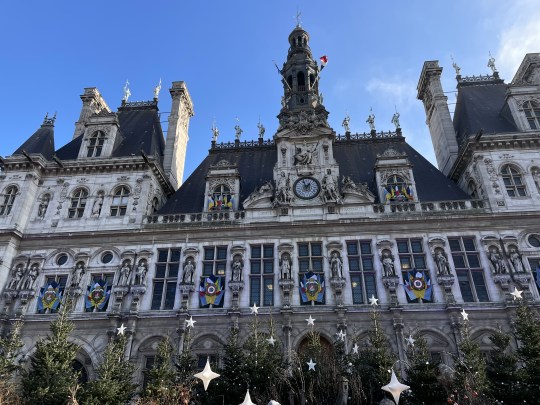
At two o’clock, right on time, we arrived at the Musée Jacquemart-André, not far from the Champs-Élysées. Like the Wallace Collection in London this museum was formed from a private collection—a couple, in the nineteenth century, whose love of art led them to amass a remarkable gallery of paintings and artefacts. They loved the art and history of Italy the best, and much of the collection comprises renaissance frescos, church carvings and depictions of the holy mother and child. The mansion they built to display their prized objects was beautiful enough in itself, and barely frequented by tourists except for us two. Compared to the other more frenetic galleries that Paris has on offer, where the impenetrability of the crowd might make it near impossible to see more than two square inches of a picture at once, it felt like a worthy use of time.
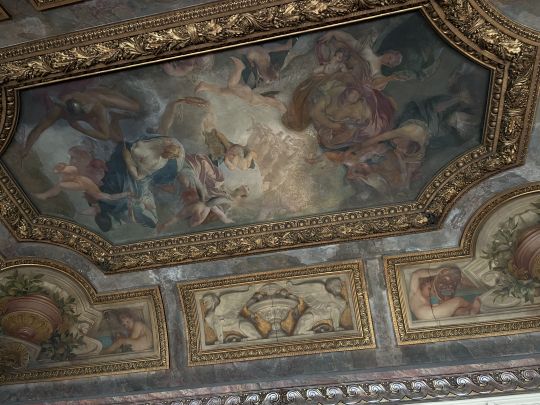
In the museum’s temporary exhibit was a collection of paintings by Fuseli, whose name I knew but whose art I would not have been able to place. These dark and fantastical works are very unique in style—disturbed and neurotic and sensational, in a way one rarely expects to see from his era. The exhibition centred around his obsession with narrative, whether it was Shakespeare’s theatre or spectacular Norse myth, and the psychological, in the form of the dream, the hallucination, the desire. As much as I loved the thespian allure and fantasy of his Shakespeare paintings, his piece entitled The Shepherd’s Dream, the last work shown, was my favourite. There was a loveable horror to how every corner of this painting revealed a new twisted fairytale creature—some pixie or spirit or grinning gremlin, corrupting the shepherd’s peaceful sleep. Over the course of the gallery, the enigmatic Fuseli appeared piece by piece; one wasn’t sure what to make of him, except that perhaps only a true mad genius could have spawned such gruesomely brilliant pictures.
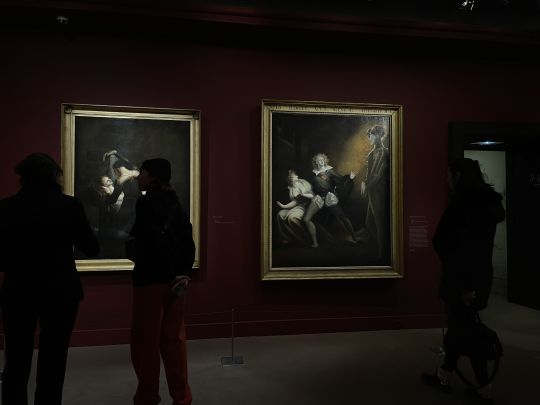

After the museum we had a little time to spare before the next booking I had made, so we strolled up the road to see the Arc du Triomphe and marvel at the confidence of the cars and motorcycles that went shooting through into the centre of the torrid vehicular whirlpool, apparently reassured of coming out intact on the other side. The trees hid the great arch from us for a long time as we approached, but when it finally revealed itself it did so from the optimal three-quarter angle against the setting sun. The Champs-Élysées were more embedded with tourist magnets than anywhere else we had been so far, though still not nearly in the way London’s inner streets were earlier in the week. Untempted by the French versions of all the same shops we have in Australia, we re-boarded the metro and made for the lower streets of the Montmartre.
Our early evening was spent in the fromagerie Monbleu, where we entertained the French mode de vie properly for the first time with cheese and fresh bread and wine. We chose the Comté and the Napoléon and the Camembert—the restaurant selected the fourth cheese for us. All were incredibly delicious and distinct from one another, eaten in generous wedges on the pieces of crusty white, brown and fruited breads with scrapes of jam or slivers of pickle onion. Washed down with a glass of wine as darkness took hold beyond the heated interior, it was the perfect way to spend a Parisian winter’s late afternoon.


Our return walk took us through the second arrondissement and its arcades of historic bookshops and boutiques all the way to the Palais Garnier, where we witnessed the opera house’s façade lit up for night. We were quite full up on delicious cheese, so there was no discomfort in waiting up a while back at the hotel for our more classically French nine o’clock dinner booking, at a traditional bistro called Le Colimaçon. This was more my treat than Mum’s, as the vegetarian option —a melange of salad and roast vegetable sides ripped from the plates of the meat dishes—was so obscure it was not even menu-listed. I had steak tartare and frites, eaten with a reverence only broken by disbelieving glances in the direction of the couple sitting next to us, who we obsessed over most of the evening.
They were remarkable. This pair were young and loud and expensively English, as crass about their class of wealth as they were about the food; their topics of conversation, heard by the entire room, progressed naturally from the jewellery business to the selling of a hundred thousand pounds in shares to whether they should stay in Derbyshire to a completed unprompted tirade in defence of the British monarchy. The entire restaurant was turning its heads at intervals to look at this bizarre display of social caricature. They continued to entertain us throughout a dessert of crème brulée and chocolate mousse—both good, but the mousse particularly incredible, a pure mouthful of rich dark cocoa cream. Leaving this show of human oddity behind in the little bistro’s second-floor dining room, we returned to the chilly streets and to the platforms where the prompt arrival of the metro promised an easy journey home.
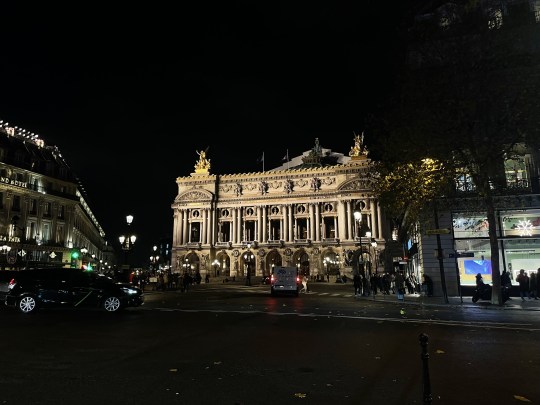
0 notes
Text
November 17
I was interested in what was going on, I assure you, I liked what I was seeing, but I was tired. I propped my head on my angled wrist and shallowly slept, rising and diving, duck-like. If I continued to fight to stay awake, there was danger of falling into deeper sleep, real sleep, and potentially interrupting my research.
The film continued on without me, three or four voices tops in French sometimes whispering, calling, shouting. Since it made no sense to me I could easily wander through a million places where I was a stranger. From time to time, Clay looked over at me, to see, probably, whether I was asleep. I hate that, when people glance at you sideways during a movie, to see if you're laughing or repulsed or a sleep.
Somewhere towards the end, I tapped back in, regretful that I'd been so tired during this movie rather than something I was just seeing in order to spend time with someone or to fulfill some obligation or to tick a box. I'd probably leave the middle of the movie unwatched, remembering the Rivoli with its fake sky ceiling and castle walls and little lightbulb stars high above, and and that time in my life, my twenty eighth year. A rich person or people had moved back to town and was finally correcting the theatre. Instead of whatever few new movies they could squeeze that were playing at the multiplex across town, whatever town, they were playing two thirds classics.
Clay was a sensitive guy and I was discontent. Watching movies together at the Rivoli was a good or maybe our only reasonable meeting ground. We didn't have to endure the awkward funk of each other's antisocial living situations- his, a studio apartment, mine, my mother's house. He didn't drink, and even if he did, somehow every bar in the sea of bars in our town was a dump. Even the more approachable ones had problems: smelling like honey buckets, Facebook racists, pedophilic kitchen staff, loud karaoke.
On the way home, at a red light, the license plate of a white sedan in front of me read JAN 666 and a cop wizzed by me with what sounded like a new siren, one I'd never heard before. They had a whole block surrounded when I saw them again half a mile later.
1 note
·
View note